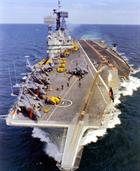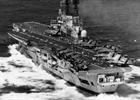On this 25 February 1955
On this day 25 February 1955 HMS Ark Royal IV commissions. First Royal Naval carrier built with an angled deck
Ark Royal had a 5.5° partially angled flight deck, two steam catapults capable of launching aircraft weighing up to 30,000 pounds (14,000 kg), a deck-edge lift on the port side (the first British ship to be fitted with such a device). The angle of the deck was modified to 8.5° during a refit in the late 1960s.
The angled deck started as a ‘doodle’ by Captain, later Rear Admiral Denis Cambell in 1951. Aircraft were getting heavier and faster but they were still being landed on a straight deck along the fore and aft axis of the ship where, to miss the wires, meant certain entry into the barrier or landing in the deck park in the bows – a crash in either case.
Cambell’s solution -‘out of the blue’- to quote him was to shift the landing axis ten degrees to port. This would at once give the pilot a clear approach and overshoot path such that if he missed the wires he would only have to apply power and go round again. Furthermore it would do away with the need for barriers, reduce the number of arrester wires required, open up a larger deck park and speed up deck operations.
The Americans saw the benefits faster than the British, and whilst the Admiralty were still ‘considering’ the issue, in 1953, the Americans sailed one of their carriers, the USS Antietam into the Channel with the wires angled off and a slanted centre line at ten degrees to port! This was not only to show us the whole idea worked but also a tacit acknowledgement that the Brits had thought of it first.
Commander Graeme Rowan-Thomson flying a Sea Hawk was one of the first Royal Navy pilots told to try it out. It worked magnificently, the Admiralty were convinced and HMS Ark ROYAL was the first carrier built with an angled deck but HMS Centaur, built in 1948 was the first carrier to be modified. Throughout the whole development and research period, Cambell was partnered by Lewis Boddington, the civilian technical officer in charge of the Naval Air Division at RAE Farnborough whose contribution to the project was considerable. All carriers operating high performance conventional aircraft have since had angled flight decks and it was only phased out in the Royal Navy after 20 years with the introduction of the VSTOL era.


